Lessons, luck, and the Land Lotto
... Tim Green’s (1878-1937) search for a career and his future
One of the things I find most enjoyable about genealogy research is discovering family ties to interesting historical events. Before embarking on this journey I had only a little knowledge of the events surrounding the Oklahoma land rush. Outside of a brief mention of it in my elementary school days and my movie memory of Tom Cruise and Nicole Kidman participating in a horse and covered wagon race over the grassing plains to stake their claim on a piece of land, I had little knowledge of the Oklahoma land rush. And while the 1992 movie, Far and Away, did a nice job of providing some insights into the first OK land rush of 1889, my research had me more interested in the event that occurred several years later in 1901. This was the event that brought my relatives, specifically Timothy Green (my great-grandfather) to Oklahoma.
Before I dive into the events of 1901 and Tim Green’s (1878-1937) motivation to enter his name in the El Reno Land Lotto, I thought it might be helpful to take a look at the events that lead up to his participation. I’ve been fortunate to uncover some interesting pieces about Tim’s early life, but to give these a bit more context I need to backtrack a little.
Tim Green was born in Wabash, Indiana on June 28, 1878. He was the 7th child and 5th son born to Oscar Green (1844-1911) and Mary Delight Hummel (1844-1902). Not long after Tim was born, his family moved to Osage County, Kansas (just south of Topeka).
Tim’s father, Oscar Green, was a Union Army Civil War veteran who became an ordained minister for the First Christian Church after the war in 1868. The family settled near Vassar, KS, in the Junction township of Osage County in 1879. Here, Oscar took up farming while also serving as the township’s elected trustee and a local minister.
Tim and his younger brother Robert attended elementary school at the Knopf school, District 45, about 2 miles west of Vassar. In my online sleuthing, I found several news items providing updates from the school’s teacher on student attendance, examinations, and “deportment” (a student’s conduct in school). Timothy and Robert were frequently given high marks in all three categories as exemplified in the two news items below. Tim and Robert Green would have been 17-18 years and 14-15 years of age respectively, when these reports were published.
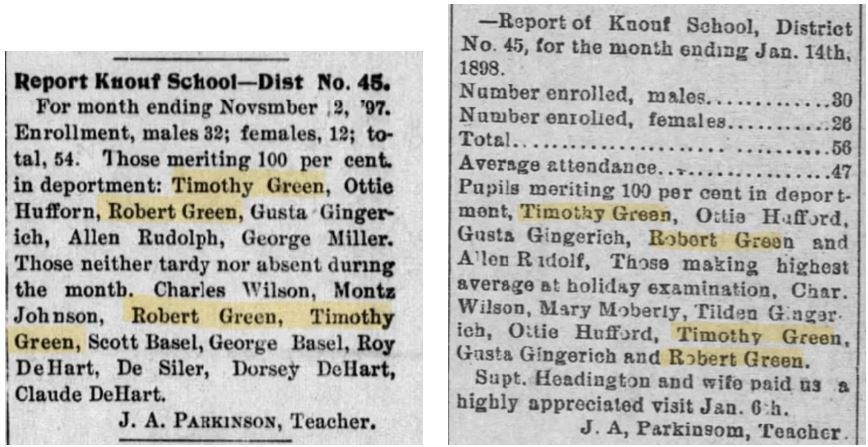
I find it interesting that the school size mentioned in both reports hovered just around 50 students (+ or - 4). By today’s education standards, that’s an extremely high teacher-student ratio. Add onto this fact that the teacher would have been responsible for educating students in all grades (from first to graduation) and it’s pretty easy to comprehend just how difficult the job of a school teacher in the late 1800s could be.
In the spring of 1899, Tim passed his final common school examinations earning him the title “graduate.” With his grammar and primary studies now behind him, it was time for Tim to consider a career path for his future.
As I discovered this next part about Tim’s search for his future it was a little surprising to me to learn that Tim, after just passing his common school exams, had set his aspirations on getting a job as a school teacher. Prior to researching this chapter, I was under the impression that most school teachers in the late 1800s had at least a little bit of advanced education before they entered the classroom. However, as I learned in following Tim’s career search and progression, that was not always the case, nor the norm.
In the late 1890s teachers were in very high demand all across the western plains. The population growth of Kansas exploded in the late 1800s with the passing of the Kansas-Nebraska Act of 1854 and the Homestead Act of 1862. Immigrants, settlers, and families flocked to the grasslands of Kansas in pursuit of land and opportunity, bringing hundreds and thousands of youth also in need of education. By 1872, the Common School Reform Movement, which advocated for a public education for all children, had been adopted by all states in the union. One-room schoolhouses were common in nearly every community across the United States.
In order to keep up with the demand for teachers, many communities and counties routinely hosted “teachers institutes” as a way to both recruit and train new teachers for the classroom. In Osage County alone (the county in which the Green family resided) there were 120 schools to staff in 1889, most of them one-room schoolhouses.
In the summer of 1899, a mere two months after passing his graduate exams, Tim registered to attend the Osage County Teacher Institute in Lyndon (10 miles southwest of Vassar) in the hopes of earning a teaching certificate. I guess he figured he had done well enough in school as a student, that being a teacher couldn’t be that much of a stretch.
From what I can gather, the Osage County Teacher Institute was an annual summer event that both current and prospective teachers could attend. Through a series of lectures and classes, participants prepared for a ‘teachers exam’ at the culmination of the event. If they passed, they received the credentials to teach grammar and common school in Kansas. This 3-5 day institute provided the primary means to staff all 120 schools within Osage County. The enrollment for the summer institute was well publicized in local newspapers. The article below covers the Institute’s enrollment in June 1899, with Tim Green among the participants.

Additionally, in the pursuit of filling open teacher positions, it was standard practice to publish the exam results for all of the Institute’s participants who passed the exam in the newspaper. Those who didn’t pass were spared the humiliation of having their failing exam grades published in the paper for everyone to see.
Tim Green was fortunately successful in passing the exam. But, unfortunately he did not test as well as others in the subjects of grammar, arithmetic, and U.S. history. His overall performance only merited a 72. Tim’s Vassar school classmate Martin (noted two names below Tim’s in the article below) fared much better with an overall grade of 90. Tim’s highest exam grades came in writing and reading. One could argue, that these are the most important exams to do well in, as these subjects were fundamental to all the others. But some might argue otherwise. The important thing for Tim was that he did pass, allowing him to enter the teacher employment pool.

With a teaching certificate achieved Tim set out to secure himself a job. This apparently was not as easy as it would seem to be. The news items below appeared in local papers, noting both Tim’s search and final success.

In September of 1899, Tim was 21 when he landed a teaching job with the Valley School just a few miles west of the town of Melvern. The position paid $35/month (roughly $1,325/month in 2024 dollars). Interestingly, the physical location of this school now exists underneath Lake Melvern. In the 1970s the area was damned by the Corp of Engineers to create water reserves. This 1899 map of the school districts in the southern half of Osage County shows the location of Tim’s school in District #43. I’ve also circled in red where Tim’s family lived, near Vassar, approximately 18 miles away.
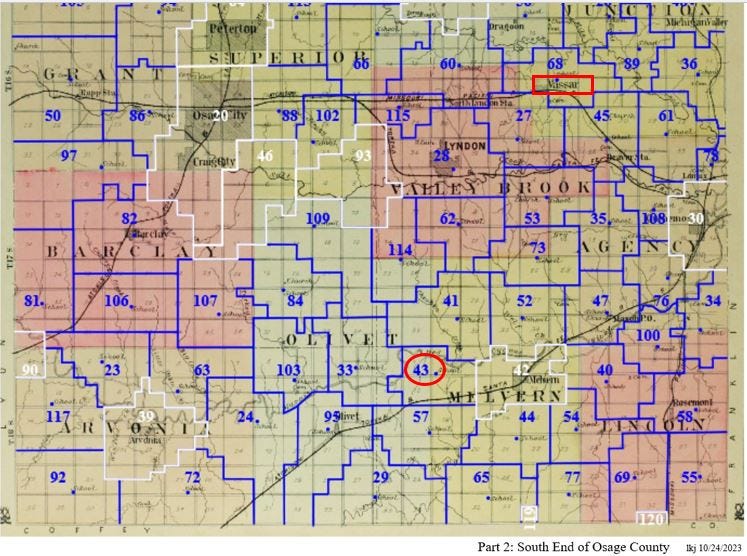
It appears that after one year of teaching for the 1899/1900 school year, Tim may have had enough, for he did not return for a second year. I suspect that being a one-room school teacher was much harder than he anticipated, and the pay was well below what he had been expecting. As a first-year teacher, I’m sure he felt overwhelmed by all the advanced preparation necessary for his teaching lessons, while also trying to keep up on in-class assignment development, in addition to grading homework. Being a school teacher for multiple grade levels in a small one-room schoolhouse was not an easy task, even for the most accomplished of teachers. You were not only responsible for the students and lesson plans, but you were also responsible for maintaining the physical school environment, including keeping the wood stove burning in cold weather and the schoolhouse environment clean. In short, it was a difficult job. This is perhaps one of the reasons that Tim decided to rethink his career choice and throw his name into the Oklahoma Land Lotto in the summer of 1901.
In the summer of 1901, Tim was a 23-year-old young man still searching for his calling in life when the announcement for the El Reno Land Lotto blanketed newspapers all over the Midwest. Tim, like many, saw this as a new opportunity to potentially make a future for himself.
On July 8, 1901, the lead story in The Wichita Beacon announced the opening of the former Kiowa, Comanche, and Apache lands for settlement. Earlier that same day Theodore Roosevelt had proclaimed the official opening of these lands in the Oklahoma Territory. Homesteader application was to be done in a new way, by a lotto selection. There would be no more crazy and contentious land runs across the plains to plant a wooden stake on a plot of land. Interested potential homesteaders would have to patiently wait to see if they were lucky enough to have their name pulled.
This new proclamation represented the last significant opportunity for homesteaders to stake their claim on 160 acres within the Oklahoma Territory. The first took place in 1889 when President Benjamin Harris authorized the opening of some territorial “unassigned lands” creating the first of several land rushes. In a matter of just a few weeks, tent towns popped up all around the “unassigned lands” fringes anticipating, as settlers anticipated the opportunity to “rush and claim free land.”
As I mentioned in the opening of this chapter, the movie Far and Away does an excellent job of portraying the mayhem associated with this land giveaway. In total, there were five land “rushes” between 1889 and 1895 before the lotto system was introduced. The El Reno Lotto marked the last of the great land giveaways. In this lotto over 2 million acres of former Indian territories (vacated as part of the Jerome Agreement of 1892 with Kiowa, Comanche, Apache, Wichita, and Caddo tribes) were given away between two districts; El Reno and Lawton, O.T.
Before the land lottery was announced I suspect that Tim may have already been thinking about homesteading in Oklahoma, and perhaps had even visited with family or friends who had already settled in the area. In the summer of 1900, this short news item appeared in the Quenemo Republic noting Tim’s recent visit and report on the corn crop in the O.T.
Further impacting Tim’s life during this time period was his parents’ decision to relocate to Bethany, MO in February 1900. With their move, he no longer had a familiar home base to shelter in as he continued to contemplate his future. As such, I believe that Tim moved in with his sister Kate in Topeka (approx. 40 miles north of Vassar) after his year of teaching.
Tim’s older sister Louisa Catherine “Kate” (1870-1956) was married to Frank Blanch, a successful contractor and construction businessman. He had built a solid reputation building large structures like schools and city municipal carriage barns in Topeka. I suspect that Tim may have worked for his brother-in-law during the fall of 1900 after making the decision not to return for a second year of teaching. I wonder if, during this brief stay in Topeka, Tim didn’t also gain some carpentry experience that would come in handy several years later as he embarked on his landlord side-business.
Although I can’t be sure about my Topeka speculations, what I am quite certain about is that in July of 1901, Tim traveled to El Reno, O.T. to enter his name in the land lotto. When he filled out his registration card he identified “Topeka” as his home location. And when he registered he also selected the “southern district/Lawton” as his preference for land. Once registered, Tim would have been given an entry pass to travel to the area to scope out his potential claim in advance, conditional of course, on being lucky enough to have his name pulled.
The lotto drawing itself took place at El Reno over the course of multiple days starting July 29, 1901. There were approximately 500-750 names drawn each day. Once drawn, the name and location of the individual were read aloud along with the land district desired. Those that weren’t at the drawing in person could consult the local papers which printed the names daily of those lucky enough to be drawn. This process went on for over a week with the last day of the lotto falling on August 6, 1901. In total 6,500 names were drawn from over 170,000 total registrations, enabling them to stake a claim on 160 acres.
One thing that surprised me in my research was that the lotto was open to everyone regardless of citizenship status, race, or sex. The only real stipulation was that there could only be one (1) entry per family. This meant that single women, widowers, African Americans, and even Native Americans were all eligible to enter the lotto. At a time when many of these groups didn’t even have the right to vote, this seems remarkable to me. Surprisingly, the second name pulled on the first day of the drawing was a 21-year-old woman, Miss Mattie H. Beals, who was a telephone girl from Wichita, Kansas. Miss Beals would select a prime location near the town of Lawton, and after her marriage, she would become wealthy from the sale of her land in one-acre allotments. To this day, the Mattie Beals mansion is one of the finest homes in Lawton. Here are a few photos from the historic land event that show the events around the Lotto drawing.


Although I’m not sure if Tim attended the multi-day drawing in person, I’m pretty sure he must have watched the daily newspaper lotto updates in anticipation. For nearly a week Tim’s scan of the hundreds of published names yielded no results. But on the very last day of the lotto, August 6th, 1901, Tim got lucky when his card was pulled. His name appeared in the Kansas Farmer Mail & Breeze newspaper as one of several Topekans to be the lucky ones on the last day.
I suspect that Tim did visit the Lawton area to scout his potential claim in advance of the actual lottery because the filing of his actual claim was divided between two quarter sections of the actual land survey. Instead of registering for one 160-acre “quarter section” (as originally surveyed), Tim’s registration was for 80 acres from one-quarter section adjoining to 80 acres along another. In looking at the survey itself, it becomes apparent why he did this. Tim had selected the best half from each of two adjoining quarter sections, providing him with an elongated claim that had a stream running its entire length. Most claims were made by selecting a full 1/4 section claim, but Tim’s was unique in diverging from this pattern.

Today the land that Tim selected to homestead remains still largely open and undeveloped beyond farming. You can find the northern end of Tim Green’s original claim along Cache Rd at Latitude: 34.62156 Longitude: -98.59103 (link to Google Maps). If you compare this current satellite image to the 1894 survey, it’s easy to see that the stream on the property remains relatively unchanged.
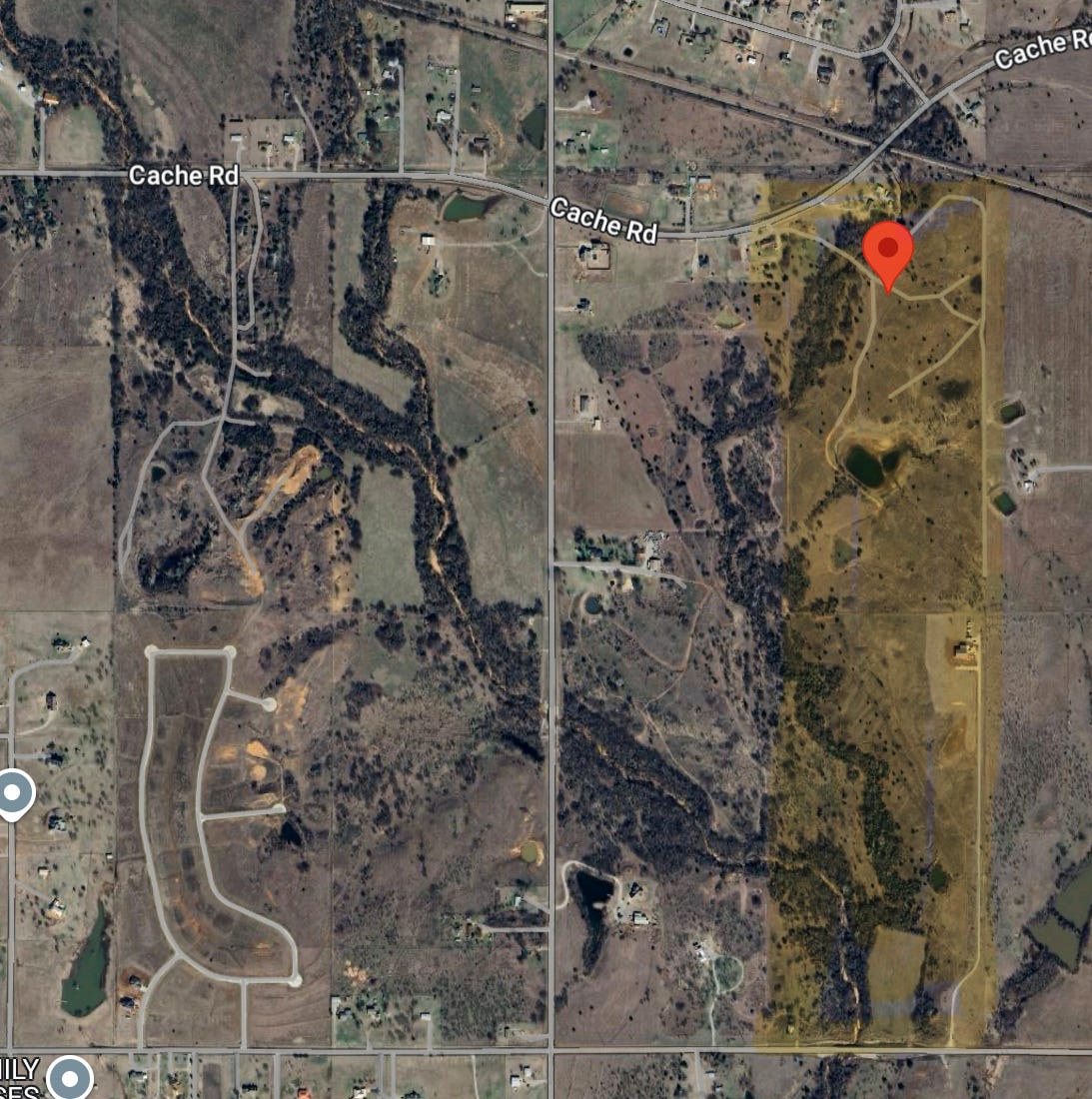
When Tim arrived in Lawton to stake his claim in the late summer of 1901, the town was nothing more than tents roughly arranged in a street grid. The photo below of G Ave (which was locally called “Goo Goo” Ave) was taken in August 1901.
By the fall of 1901, tents were being replaced by more permanent buildings. Tim's homesteader claim was approximately 15 miles directly west of Lawton, O.T.

As shared in an earlier chapter, it is apparent that Tim did not homestead this land himself for very long. Homesteaders could bypass the five-year residency requirement by paying $1.25 / acre after only living on the property for 6 months. Tim must have taken this option because, by June of 1903, he was embarking on a new career as one of Lawton’s first mailmen. His actual claim was recorded on March 8, 1904.
Tim’s claim was recorded in the Lawton Land Office as document #938 and was described as:
“the east half of the northeast quarter and the east half of the southeast quarter of section twenty-nine in township two north of range thirteen west of Indian Meridian Oklahoma containing one hundred and sixty acres”

Tim Green would end up building two homes on the land and renting them out as separate farms. It’s interesting to see in the current satellite photo already shared earlier in this chapter that it looked like there are still only two homes on the property. They appear roughly spaced so that each home has approximately eighty acres.
As noted in a previous chapters, Tim would go on to lose his lotto property several years later when he experienced catastrophic financial problems. You can catch up with the rest of the story at the chapter titled Green Family: the Lawton years.
In the end, Tim's search for his career and future would take him from the schoolhouse to homesteader. If you’ve read earlier chapters, you also know that his career search took him to trying his hand at being a landlord, and then finally to postal service mail carrier. N the end, serving in the Postal Service was apparently a good choice for Tim, who was frequently lauded for his friendliness and congeniality. (See Green Family: The Lawton Years).
Addendum:
Thanks to my cousin Marianne, who recently discovered this certificate among her “heritage photos” (I like this term, for it feels very accurate), I also now know that Tim also passed a Civil Service Exam in November 1905. I assume this exam was in conjunction with his employment with the Postal Service, but I am not fully sure. I will need to investigate further to confirm.

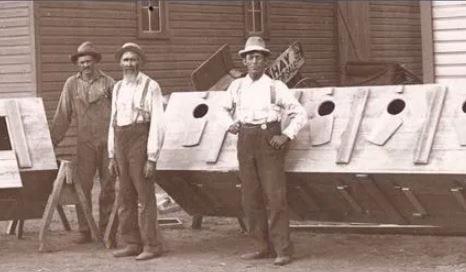



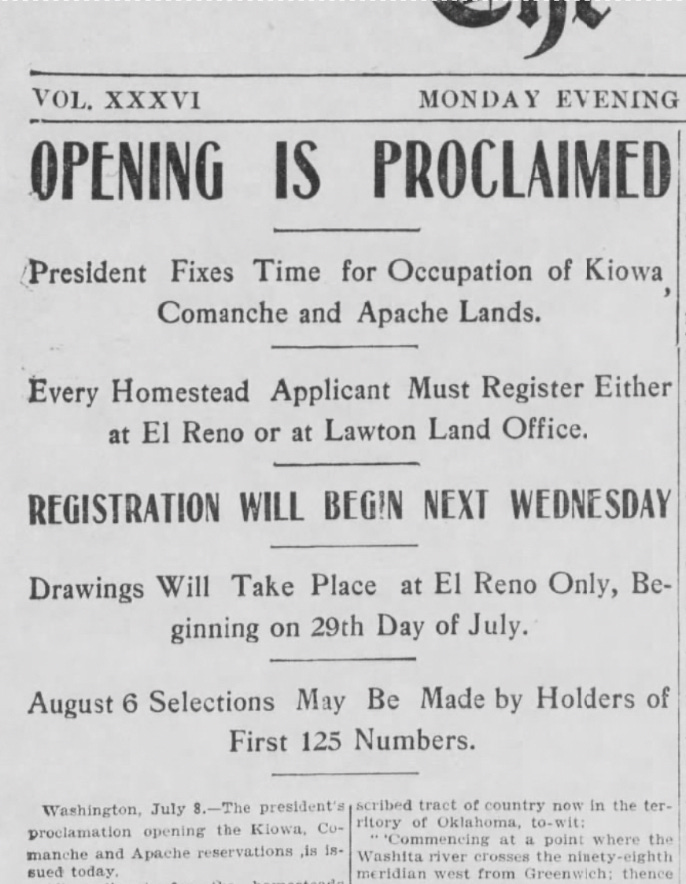


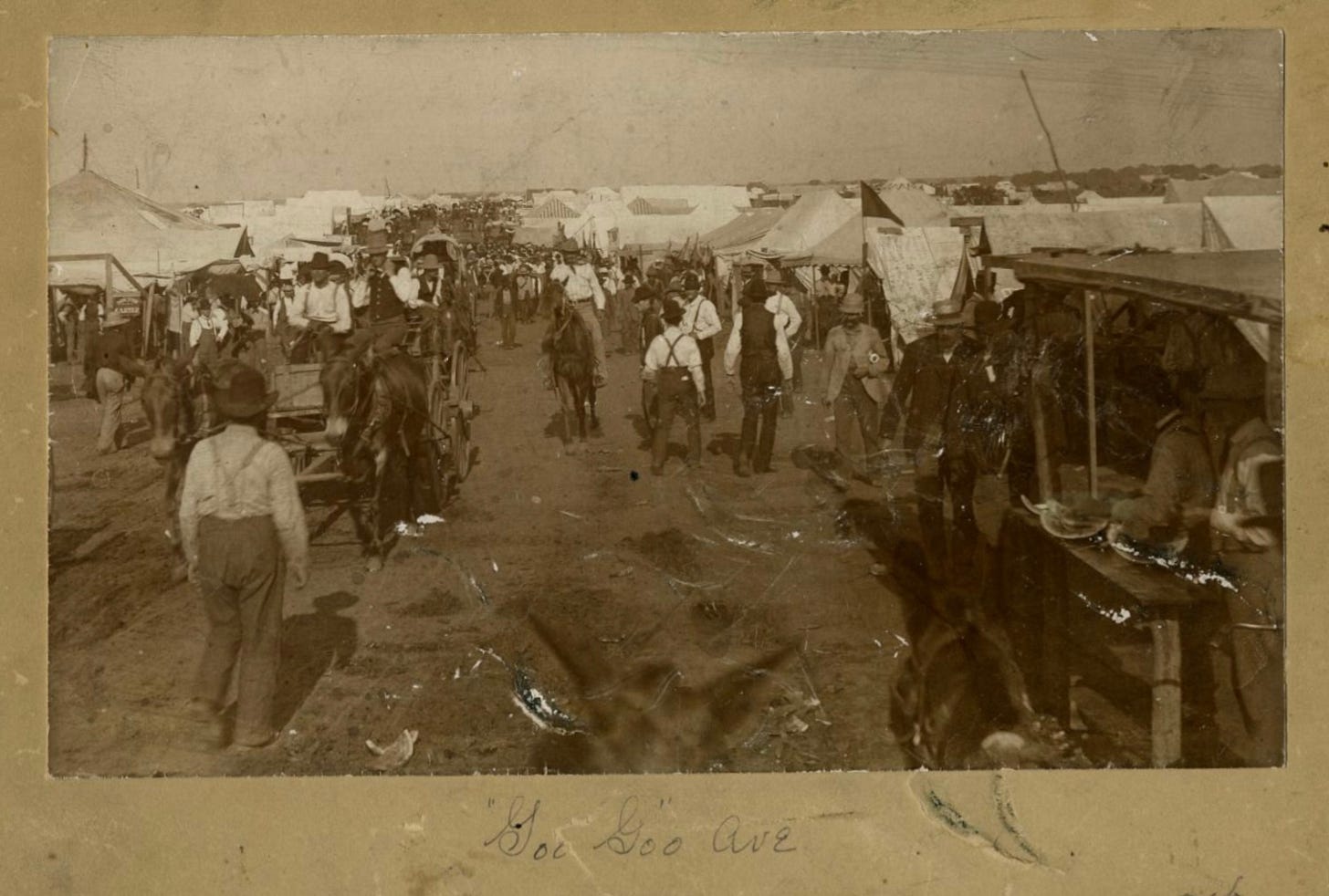




Very interesting account of one person’s experience of a land rush (or, in this case, a lottery). I knew very little about this history. Thank you!
Great storytelling of a piece of history I know little about. Thanks! My husband's family arrived shortly after the land rush and it appears they were among those who benefitted from folks like Tim who divided their lands. Oh and the maps helped tell the story so much!